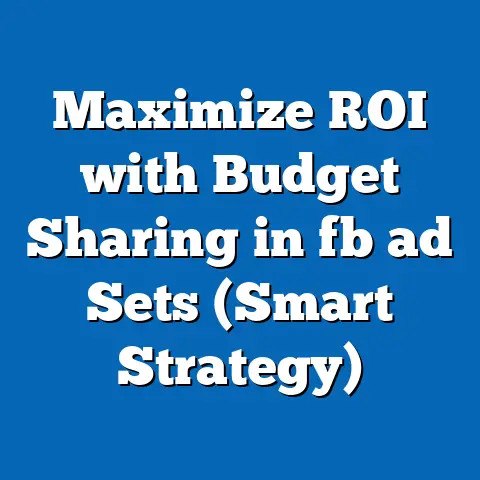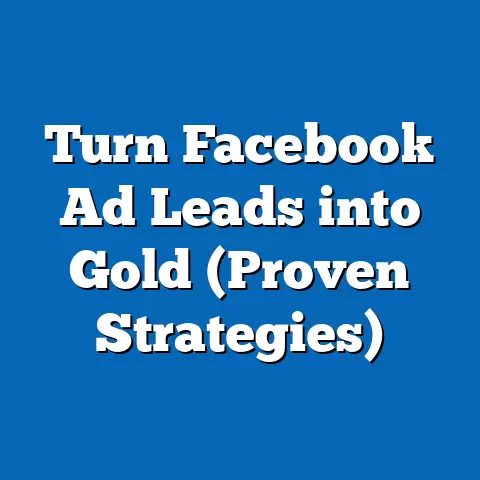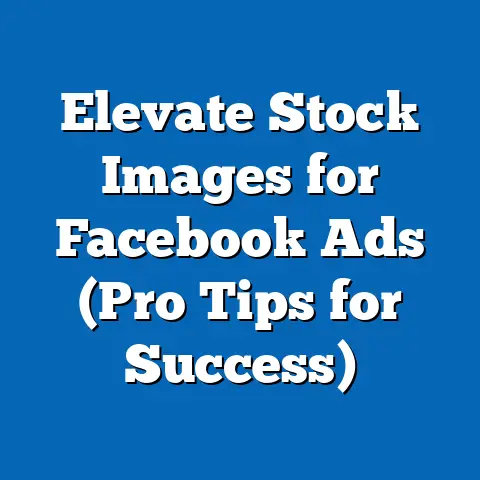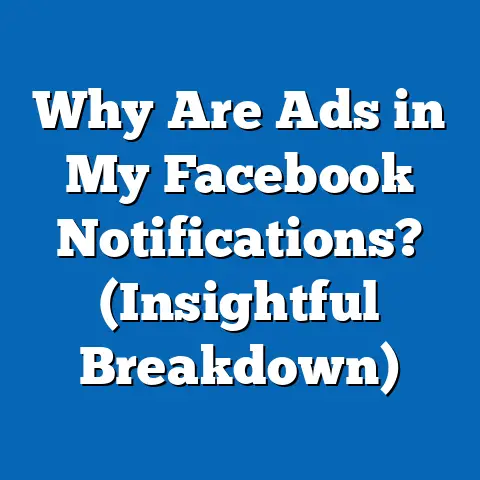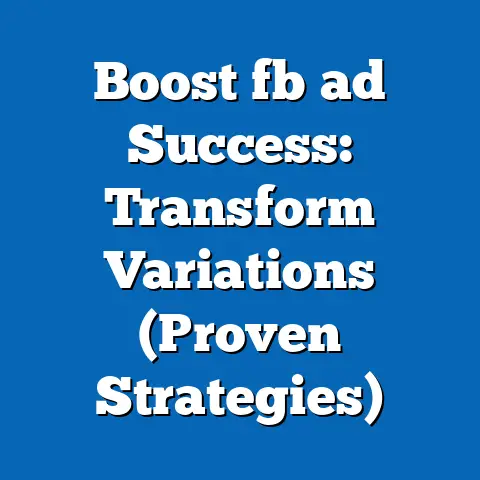Master Facebook Ad Placement Optimization (Proven Strategies)
In today’s digital age, advertising has undergone a monumental transformation, largely fueled by rapid technological advancements. We’ve moved from broad, untargeted campaigns to laser-focused strategies thanks to innovations like AI algorithms, machine learning, and sophisticated data analytics. These technologies allow us, as advertisers, to tailor our campaigns with unprecedented precision, ensuring that our message reaches the right audience at the right time. Platforms like Facebook, now Meta, are at the forefront of this revolution, offering a suite of tools that empower marketers to connect with their desired audience more effectively than ever before. I remember when I first started with Facebook ads, the targeting options felt revolutionary compared to traditional media. Now, it’s all about leveraging the power of placement to truly maximize your ROI.
Understanding Facebook Ad Placements
Ad placements, in the context of Facebook advertising, refer to the various locations where your ads can appear on the Facebook platform and its extended network. Think of it as choosing the perfect spot on a stage for your performance; the location significantly impacts how well your message is received.
Facebook offers a diverse range of ad placements, each with its own unique characteristics and advantages. Here’s a breakdown of the most common types:
-
Facebook Feed: This is the classic and arguably most familiar placement. Ads appear directly within the user’s news feed, blending seamlessly with organic content from friends, family, and followed pages. The feed is a high-visibility location, making it ideal for brand awareness and driving engagement.
-
Instagram Feed: Similar to the Facebook Feed, ads appear within the user’s Instagram feed, interspersed with posts from accounts they follow. Given Instagram’s focus on visual content, this placement is perfect for visually appealing ads that capture attention.
-
Facebook Stories: Stories are short-form, ephemeral content that disappear after 24 hours. Ads appear between organic stories, providing a full-screen, immersive experience. This placement is great for quick, engaging messages and driving immediate action.
-
Instagram Stories: Same as Facebook Stories, but on the Instagram platform. This offers a visually rich, mobile-first environment for your ads.
-
In-Stream Videos: These ads appear before, during, or after video content on Facebook. They’re a great way to reach audiences actively watching videos and can be highly effective for brand awareness and driving conversions.
-
Facebook Marketplace: This is a dedicated section on Facebook where users buy and sell items. Ads in Marketplace can target users actively looking to purchase products, making it ideal for e-commerce businesses.
-
Facebook Right Column: This placement appears on the right side of the Facebook desktop interface. While less prominent than the feed, it can still be effective for driving traffic to your website or promoting specific offers.
-
Audience Network: This extends your Facebook ads to a network of mobile apps and websites beyond Facebook. This allows you to reach a wider audience, leveraging Facebook’s targeting capabilities across a broader digital landscape.
Facebook Feed: This is the classic and arguably most familiar placement. Ads appear directly within the user’s news feed, blending seamlessly with organic content from friends, family, and followed pages. The feed is a high-visibility location, making it ideal for brand awareness and driving engagement.
Instagram Feed: Similar to the Facebook Feed, ads appear within the user’s Instagram feed, interspersed with posts from accounts they follow. Given Instagram’s focus on visual content, this placement is perfect for visually appealing ads that capture attention.
Facebook Stories: Stories are short-form, ephemeral content that disappear after 24 hours. Ads appear between organic stories, providing a full-screen, immersive experience. This placement is great for quick, engaging messages and driving immediate action.
Instagram Stories: Same as Facebook Stories, but on the Instagram platform. This offers a visually rich, mobile-first environment for your ads.
In-Stream Videos: These ads appear before, during, or after video content on Facebook. They’re a great way to reach audiences actively watching videos and can be highly effective for brand awareness and driving conversions.
Facebook Marketplace: This is a dedicated section on Facebook where users buy and sell items. Ads in Marketplace can target users actively looking to purchase products, making it ideal for e-commerce businesses.
Facebook Right Column: This placement appears on the right side of the Facebook desktop interface. While less prominent than the feed, it can still be effective for driving traffic to your website or promoting specific offers.
Audience Network: This extends your Facebook ads to a network of mobile apps and websites beyond Facebook. This allows you to reach a wider audience, leveraging Facebook’s targeting capabilities across a broader digital landscape.
Each placement offers distinct advantages. For instance, Feed ads are excellent for broad reach and engagement, while Marketplace ads are ideal for targeting users with purchase intent. Understanding these nuances is crucial for crafting effective ad campaigns. I’ve found that a campaign that performs exceptionally well in the Facebook Feed can completely flop in Instagram Stories, highlighting the importance of tailoring your creative and message to each specific placement.
Takeaway: Familiarize yourself with the different Facebook ad placements and their unique characteristics. This knowledge is the foundation for effective ad placement optimization.
The Importance of Ad Placement Optimization
Ad placement optimization is not just a nice-to-have; it’s a critical component of maximizing your return on investment (ROI) on Facebook ads. Think of it as finding the perfect fishing spot – cast your net in the right place, and you’ll reel in a bountiful catch.
Why is it so important?
-
Improved ROI: By placing your ads where they’re most likely to be seen and engaged with by your target audience, you’ll get more bang for your buck. This means higher click-through rates (CTR), lower cost per click (CPC), and ultimately, more conversions.
-
Increased Engagement: The right placement can significantly boost engagement. For example, visually appealing ads in Instagram Stories often generate higher engagement rates than ads in the Facebook Feed.
-
Enhanced Brand Awareness: Strategic ad placements can increase brand visibility and recognition. Consistently showing up in relevant placements helps build brand awareness and familiarity.
-
Reduced Ad Fatigue: Showing the same ad in the same placement repeatedly can lead to ad fatigue, where users become desensitized to your message. Diversifying your placements helps keep your ads fresh and engaging.
-
Better User Experience: Irrelevant or poorly placed ads can disrupt the user experience and damage your brand’s reputation. Optimized placements ensure that your ads are relevant and valuable to the user.
Improved ROI: By placing your ads where they’re most likely to be seen and engaged with by your target audience, you’ll get more bang for your buck. This means higher click-through rates (CTR), lower cost per click (CPC), and ultimately, more conversions.
Increased Engagement: The right placement can significantly boost engagement. For example, visually appealing ads in Instagram Stories often generate higher engagement rates than ads in the Facebook Feed.
Enhanced Brand Awareness: Strategic ad placements can increase brand visibility and recognition. Consistently showing up in relevant placements helps build brand awareness and familiarity.
Reduced Ad Fatigue: Showing the same ad in the same placement repeatedly can lead to ad fatigue, where users become desensitized to your message. Diversifying your placements helps keep your ads fresh and engaging.
Better User Experience: Irrelevant or poorly placed ads can disrupt the user experience and damage your brand’s reputation. Optimized placements ensure that your ads are relevant and valuable to the user.
Statistics and case studies consistently demonstrate the impact of effective ad placements on campaign success. For instance, a study by Facebook found that campaigns using automatic placements achieved a 13% lower cost per acquisition (CPA) compared to those using manual placements. This highlights the power of letting Facebook’s algorithm optimize your placements.
The correlation between ad placement and audience engagement is undeniable. Imagine showing a video ad for a new gaming console to someone browsing Facebook Marketplace – it’s unlikely to resonate. However, the same ad shown to gamers watching a video on Facebook Gaming is far more likely to capture their attention.
I’ve personally witnessed the dramatic impact of ad placement optimization. In one campaign for a local restaurant, we initially focused solely on the Facebook Feed. While we saw some results, they were underwhelming. After experimenting with Instagram Stories and targeting users interested in food and dining, we saw a significant increase in engagement and reservations.
Takeaway: Ad placement optimization is essential for maximizing ROI, increasing engagement, enhancing brand awareness, reducing ad fatigue, and improving the user experience.
Proven Strategies for Optimizing Facebook Ad Placements
Now that you understand the importance of ad placement optimization, let’s dive into proven strategies you can implement to improve your Facebook ad performance.
1. Audience Targeting and Segmentation
Understanding your target audience is paramount to successful ad placement optimization. You need to know who you’re trying to reach, what their interests are, and where they spend their time on Facebook.
Facebook offers a wealth of targeting options, allowing you to reach specific demographics, interests, behaviors, and connections. Here’s how to leverage these features for placement strategy:
- Demographics: Target users based on age, gender, education, location, and other demographic factors.
- Interests: Reach users interested in specific topics, hobbies, and activities.
- Behaviors: Target users based on their online behavior, such as purchase history, device usage, and travel habits.
- Connections: Reach users who are connected to your Facebook page or have interacted with your ads in the past.
Custom Audiences are a powerful tool for targeting existing customers or website visitors. You can create custom audiences by uploading a list of email addresses, phone numbers, or website visitors. This allows you to re-engage with users who have already shown interest in your brand.
Lookalike Audiences allow you to reach new users who are similar to your existing customers. Facebook analyzes your custom audiences and identifies users with similar characteristics and interests. This is a great way to expand your reach and find new customers who are likely to be interested in your products or services.
When crafting your placement strategy, consider how your target audience interacts with each placement. For example, if you’re targeting young adults, Instagram Stories might be a more effective placement than the Facebook Right Column. If you’re targeting users with purchase intent, Facebook Marketplace could be a great option.
Takeaway: Deeply understand your target audience and use Facebook’s targeting features to reach them effectively. Tailor your placement strategy based on their demographics, interests, behaviors, and connections.
2. Testing Different Placements
A/B testing is a crucial method for determining the most effective placements for your ads. It involves creating multiple versions of your ad with different placements and comparing their performance.
Here’s how to set up tests for different placements:
- Create Multiple Ad Sets: In Facebook Ads Manager, create multiple ad sets, each targeting the same audience but with different placements.
- Vary Placements: In each ad set, select different placements to test. For example, you could create one ad set with Facebook Feed, another with Instagram Stories, and another with Audience Network.
- Run Your Ads: Run your ads for a sufficient period of time to gather enough data. I recommend at least a week or two, depending on your budget and traffic volume.
- Analyze Results: Monitor key performance indicators (KPIs) such as impressions, CTR, CPC, and conversion rates for each ad set. Identify which placements are performing best.
Metrics to Monitor:
- Impressions: The number of times your ad was shown.
- CTR (Click-Through Rate): The percentage of people who saw your ad and clicked on it.
- CPC (Cost Per Click): The average cost you paid for each click on your ad.
- Conversion Rate: The percentage of people who clicked on your ad and completed a desired action, such as making a purchase or filling out a form.
By analyzing these metrics, you can identify which placements are driving the best results for your campaign. I’ve found that testing different placements often reveals surprising insights. For example, a placement I initially dismissed as ineffective sometimes outperforms my expectations, highlighting the importance of data-driven decision-making.
Takeaway: Conduct A/B testing to determine the most effective placements for your ads. Monitor key performance indicators and analyze the results to inform future placement decisions.
3. Leveraging Facebook’s Automatic Placement Feature
Facebook’s automatic placement feature is a powerful tool that can simplify your ad placement strategy. It allows Facebook’s algorithm to automatically determine the best placements for your ads based on your campaign objectives and target audience.
How does it work?
- Algorithm-Driven Optimization: Facebook’s algorithm analyzes data from millions of ad campaigns to identify the placements that are most likely to drive results for your campaign.
- Real-Time Adjustments: The algorithm continuously monitors your ad performance and makes real-time adjustments to your placements, ensuring that your ads are always shown in the most effective locations.
- Simplified Management: Automatic placements simplify campaign management by eliminating the need to manually select and optimize placements.
Advantages of Automatic Placements:
- Improved Performance: In many cases, automatic placements can outperform manual selections, as Facebook’s algorithm is constantly learning and optimizing.
- Time Savings: Automatic placements save you time and effort by automating the placement optimization process.
- Wider Reach: Automatic placements can help you reach a wider audience by showing your ads in a variety of placements.
Scenarios Where Automatic Placements Might Outperform Manual Selections:
- Limited Data: If you’re launching a new campaign and don’t have much data on which placements perform best, automatic placements can be a great starting point.
- Broad Targeting: If you’re targeting a broad audience, automatic placements can help you reach users across a variety of placements.
- Campaign Optimization: If you’re focused on optimizing your campaign for a specific objective, such as conversions, automatic placements can help you achieve your goals more efficiently.
However, there are also situations where manual placements might be preferable. For example, if you have a specific creative that only works well in certain placements, or if you want to control exactly where your ads are shown, manual placements might be a better choice.
Takeaway: Leverage Facebook’s automatic placement feature to simplify your ad placement strategy and improve performance. Consider using automatic placements when you have limited data, are targeting a broad audience, or are focused on optimizing your campaign for a specific objective.
4. Analyzing Performance Metrics
Analyzing performance metrics is crucial for evaluating the success of your ad placements and making informed decisions about future campaigns. Key performance indicators (KPIs) to evaluate ad placement success include:
- Impressions: The number of times your ad was shown in each placement.
- Reach: The number of unique users who saw your ad in each placement.
- CTR (Click-Through Rate): The percentage of people who saw your ad and clicked on it in each placement.
- CPC (Cost Per Click): The average cost you paid for each click on your ad in each placement.
- Conversion Rate: The percentage of people who clicked on your ad and completed a desired action in each placement.
- Cost Per Acquisition (CPA): The average cost you paid for each conversion in each placement.
How to Interpret These Metrics:
- High Impressions, Low CTR: This suggests that your ad is being shown to a large audience, but it’s not resonating with them. Consider revising your ad creative or targeting.
- Low Impressions, High CTR: This indicates that your ad is highly engaging, but it’s not being shown to enough people. Consider increasing your budget or expanding your targeting.
- High CPC, Low Conversion Rate: This suggests that you’re paying a lot for clicks, but those clicks aren’t leading to conversions. Consider optimizing your landing page or improving your ad copy.
- Low CPA, High Conversion Rate: This indicates that your ad is highly effective at driving conversions. Consider scaling up your campaign to reach a wider audience.
By analyzing these metrics, you can identify which placements are performing well and which ones need improvement. You can then adjust your placement strategy accordingly.
Takeaway: Detail the key performance indicators (KPIs) to evaluate ad placement success (e.g., impressions, CTR, CPC, conversion rates). Explain how to interpret these metrics to inform future placement decisions.
5. Creative Optimization for Specific Placements
Ad creatives should be tailored to fit different placements effectively. What works well in the Facebook Feed might not work as well in Instagram Stories or Audience Network.
Here are some tips for designing visually appealing ads that resonate with users based on the specific context of the placement:
- Facebook Feed: Use high-quality images or videos that capture attention and blend seamlessly with organic content. Keep your ad copy concise and engaging.
- Instagram Stories: Use full-screen, vertical videos or images that are visually appealing and grab attention quickly. Use interactive elements like polls or quizzes to encourage engagement.
- In-Stream Videos: Create short, engaging videos that capture attention in the first few seconds. Use clear and concise messaging.
- Facebook Marketplace: Use high-quality images of your products that showcase their features and benefits. Write clear and compelling descriptions.
- Audience Network: Use a variety of ad formats, including display ads, native ads, and video ads. Tailor your ad creative to the specific context of the app or website where your ad is being shown.
Remember, mobile optimization is critical for all placements. Most Facebook users access the platform on their mobile devices, so your ads should be designed to look great on smaller screens.
Takeaway: Discuss how ad creatives can be tailored to fit different placements effectively. Provide tips for designing visually appealing ads that resonate with users based on the specific context of the placement.
Case Studies of Successful Ad Placement Optimization
To illustrate the power of ad placement optimization, let’s examine a couple of real-world case studies.
Case Study 1: E-Commerce Brand
- Challenge: A local restaurant was struggling to attract new customers through Facebook ads. They were primarily using Facebook Feed ads, but the results were not meeting their expectations.
- Solution: The restaurant implemented the following strategies:
- Targeted Local Audience: They targeted users within a specific radius of their restaurant who were interested in food and dining.
- Instagram Stories Ads: They created visually appealing Instagram Stories ads showcasing their menu items and highlighting special offers.
- Call-to-Action Optimization: They used clear and compelling calls to action, such as “Book a Table” and “Order Online.”
- Results: The restaurant saw a significant increase in reservations and online orders. Their website traffic increased by 40%, and their sales increased by 25%.
- Targeted Local Audience: They targeted users within a specific radius of their restaurant who were interested in food and dining.
- Instagram Stories Ads: They created visually appealing Instagram Stories ads showcasing their menu items and highlighting special offers.
- Call-to-Action Optimization: They used clear and compelling calls to action, such as “Book a Table” and “Order Online.”
These case studies demonstrate the importance of understanding your target audience, diversifying your ad placements, and tailoring your ad creatives to each placement.
Takeaway: Present two or three detailed case studies of brands or campaigns that successfully optimized their Facebook ad placements. Analyze what strategies they implemented, the challenges they faced, and the results they achieved.
Future Trends in Facebook Ad Placement Optimization
The world of Facebook advertising is constantly evolving, and it’s important to stay ahead of the curve. Here are some emerging trends and innovations in Facebook ad placement optimization:
- Augmented Reality (AR) Ads: Facebook is exploring the use of AR ads, which allow users to interact with products in a virtual environment. This could revolutionize the way brands showcase their products and drive sales.
- Virtual Reality (VR) Ads: As VR technology becomes more mainstream, Facebook is likely to introduce VR ad placements. This could create immersive and engaging advertising experiences.
- AI-Powered Placement Optimization: Facebook’s AI algorithms are becoming increasingly sophisticated, and they’re likely to play an even greater role in ad placement optimization in the future.
- Personalized Ad Experiences: Facebook is likely to focus on delivering more personalized ad experiences, tailoring ad placements and creatives to individual users based on their interests and behaviors.
To prepare for these changes, advertisers should:
- Stay Informed: Keep up-to-date with the latest trends and innovations in Facebook advertising.
- Experiment with New Features: Be willing to experiment with new ad formats and placements.
- Embrace AI: Leverage Facebook’s AI-powered tools to optimize your ad campaigns.
- Focus on Personalization: Tailor your ad experiences to individual users.
I believe that the future of Facebook advertising is all about personalization and creating engaging, immersive experiences. Advertisers who embrace these trends will be well-positioned to succeed in the years to come.
Takeaway: Speculate on emerging trends and innovations in Facebook advertising, including the potential impact of augmented reality (AR) and virtual reality (VR) on ad placements. Discuss how advertisers can prepare for these changes and adapt their strategies accordingly.
Conclusion: Mastering Ad Placement for Long-Term Success
In conclusion, mastering Facebook ad placement optimization is essential for achieving sustained success in your marketing efforts. By understanding the various placement options, implementing proven strategies, and staying ahead of emerging trends, you can maximize your ROI, increase engagement, and enhance your brand awareness.
Remember, the key takeaways from this article are:
- Understand the different Facebook ad placements and their unique characteristics.
- Ad placement optimization is essential for maximizing ROI, increasing engagement, enhancing brand awareness, reducing ad fatigue, and improving the user experience.
- Deeply understand your target audience and use Facebook’s targeting features to reach them effectively.
- Conduct A/B testing to determine the most effective placements for your ads.
- Leverage Facebook’s automatic placement feature to simplify your ad placement strategy and improve performance.
- Detail the key performance indicators (KPIs) to evaluate ad placement success (e.g., impressions, CTR, CPC, conversion rates).
- Discuss how ad creatives can be tailored to fit different placements effectively.
- Stay informed about emerging trends and innovations in Facebook advertising.
As technology evolves, so too must our advertising strategies. Continuous learning and adaptation are essential for staying ahead of the curve and achieving long-term success in the realm of Facebook advertising.
Call to Action: Now, I’d love to hear from you! Share your own experiences and strategies for Facebook ad placement optimization in the comments section below. What placements have worked best for you, and what challenges have you faced? Also, don’t forget to subscribe to our newsletter or follow our blog for more insights on digital marketing trends and strategies. Let’s learn and grow together in the ever-evolving world of Facebook advertising!

